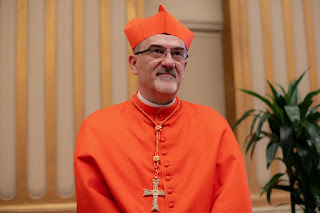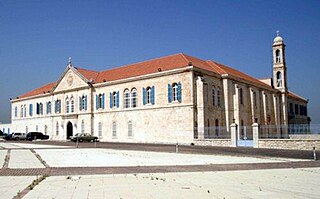
The Latin Patriarchate of Jerusalem is the Latin Catholic ecclesiastical patriarchate in Jerusalem, officially seated in the Church of the Holy Sepulchre. It was originally established in 1099, with the Kingdom of Jerusalem encompassing the territories in the Holy Land newly conquered by the First Crusade. From 1374 to 1847 it was a titular see, with the patriarchs of Jerusalem being based at the Basilica di San Lorenzo fuori le Mura in Rome. Pope Pius IX re-established a resident Latin patriarch in 1847.
The Patriarch of Antioch is a traditional title held by the bishop of Antioch. As the traditional "overseer" of the first gentile Christian community, the position has been of prime importance in Pauline Christianity from its earliest period. This diocese is one of the few for which the names of its bishops from the apostolic beginnings have been preserved. Today five churches use the title of patriarch of Antioch: one Oriental Orthodox ; three Eastern Catholic ; and one Eastern Orthodox.

The Kingdom of Jerusalem, one of the Crusader states that was created in 1099, was divided into a number of smaller seigneuries. According to the 13th-century jurist John of Ibelin, the four highest crown vassals in the kingdom proper were the count of Jaffa and Ascalon, the prince of Galilee, the lord of Sidon, and the lord of Oultrejordain.

The principality of Galilee was one of the four major seigneuries of the crusader Kingdom of Jerusalem, according to 13th-century commentator John of Ibelin, grandson of Balian. The direct holdings of the principality centred around Tiberias, in Galilee proper, but with all its vassals, the lordship covered all Galilee and southern Phoenicia. The independent Lordship of Sidon was located between Galilee's holdings. The principality also had its own vassals: the Lordships of Beirut, Nazareth, and Haifa.
The archiepiscopal see of Caesarea in Palaestina, also known as Caesarea Maritima, is now a metropolitan see of the Eastern Orthodox Patriarchate of Jerusalem and also a titular see of the Catholic Church. It was one of the earliest Christian bishoprics, and was a metropolitan see at the time of the First Council of Nicaea, but was later subjected to the Patriarchate of Jerusalem. The city remained largely Christian until the Crusades, its bishop maintaining close ties to the Byzantine Empire. After the establishment of the Kingdom of Jerusalem by the crusaders, the see was transformed into a Latin archdiocese, subordinate to the Latin patriarch of Jerusalem.

Frederick de la Roche was the sixth Latin archbishop of Tyre (1164–1174), chancellor of the kingdom of Jerusalem, and the chief diplomat of King Amalric. He was a Lorrainer, from the town of La Roche, of noble stock.

The bishop of Acre was a suffragan bishop of the archbishop of Tyre in the medieval Latin Kingdom of Jerusalem. Acre is present-day Akko, Israel.

Aimery or Aymery of Limoges, also Aimericus in Latin, Aimerikos in Greek and Hemri in Armenian, was a Roman Catholic ecclesiarch in Frankish Outremer and the fourth Latin Patriarch of Antioch from c. 1140 until his death. Throughout his lengthy episcopate he was the most powerful figure in the Principality of Antioch after the princes, and often entered into conflict with them. He was also one of the most notable intellectuals to rise in the Latin East.
William of Malines was a Flemish priest who was the Prior of the Church of the Holy Sepulchre from 1127 to 1130 and was then Latin Patriarch of Jerusalem from 1130 until his death. He is sometimes called William I to distinguish him from William of Agen, second patriarch of that name, but he was the second William to serve as prior of the Holy Sepulchre after William the Englishman.
The Diocese of Scythopolis is a titular see in Israel/Jordan and was the Metropolitan of the Roman province of Palestina II. It was centered on Modern Beth Shean (Bêsân).

The timeline of the Kingdom of Jerusalem presents important events in the history of the Kingdom of Jerusalem—a Crusader state in modern day Israel and Jordan—in chronological order. The kingdom was established after the First Crusade in 1099. Its first ruler Godfrey of Bouillon did not take the title of king and swore fealty to the Latin Patriarch of Jerusalem, Daimbert. Godfrey's brother and successor Baldwin I was crowned the first king of Jerusalem without doing homage to the patriarch in 1100. By 1153, Baldwin I and his successors captured all towns on the Palestinian coast with the support of Pisan, Genoese and Venetian fleets and also took control of the caravan routes between Egypt and Syria. The kings regularly administered other crusader states—the Counties of Edessa and Tripoli and the Principality of Antioch—on behalf of their absent or underage rulers.
The Roman Catholic Diocese of Sidon was a bishopric in the Kingdom of Jerusalem in the 12th and 13th centuries.
The Roman Catholic Archdiocese of Tyre was an archbishopric in the Kingdom of Jerusalem.
The Roman Catholic Archdiocese of Apamea was an ecclesiastical province of the Catholic Church in the Principality of Antioch from around 1110 to 1149.
William I was the second Latin archbishop of Tyre from 1128 until 1134 or 1135. He was originally from England and served as prior of the Church of the Holy Sepulchre before his appointment as archbishop.
The Latin Diocese of Tripoli was established in 1104 in the aftermath of the First Crusade. It remained a residential bishopric until 1289, after which it became a titular bishopric, which it remains today in the Catholic Church.
Latin Diocese of Tortosa in Syria was a Roman Catholic diocese established in the Syrian city of Tartus after the First Crusade. It had a resident bishop between 1128 and 1291. The cathedral of Tortosa became the site of a Marian shrine.

The Maronite Church is an Eastern Catholic sui iuris particular church in full communion with the pope and the worldwide Catholic Church, with self-governance under the Code of Canons of the Eastern Churches. The head of the Maronite Church is Patriarch Bechara Boutros al-Rahi, who was elected in March 2011 following the resignation of Patriarch Nasrallah Boutros Sfeir. The seat of the Maronite Patriarchate is in Bkerke, northeast of Beirut, Lebanon. Officially known as the Antiochene Syriac Maronite Church, it is part of Syriac Christianity by liturgy and heritage.

Peter of Limoges was the archbishop of Caesarea from 1199 until his death.
The Diocese of Gaza was a bishopric in the Holy Land. Its episcopal see was the city of Gaza and it is now a vacant Latin Catholic titular see.








